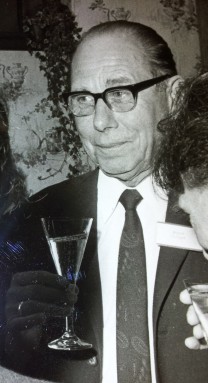Unanimously, Hans Rhotert is described as a pleasant, tactfull, generous, well-mannered and well-organized scientist: a grand seigneur.
He was born on Sept. 20th, 1900 in Hanover. As one of the youngest officers, he served in (WW I (1918). In 1919 he begun his studies in philosophy, folklore studies, history and philosophy at the University of Freiburg. One year later he moved to Munich, where he additionally studied theatre studies.
At a carnival party in the home of colonial painter von Rucketschell (1924), he met Leo Frobenius and became one of his most important students. One year later he followed Frobenius, who transferred his Institut für Kulturmorphologie from Munich to Frankfurt/Main. Nevertheless, Rhotert graduated 1927 in Germanic literature on the german-jewish poet Moses Ephraim Kuh in Munich. In the same year, he became assistant of Leo Frobenius. He admired Frobenius’ genius and his ability as writer and scientist, but also often was flabbergasted by Frobenius’ vicissitudes. Together with Frobenius, Rhotert visited Emperor Wilhelm II in exile (Doorn) - the ex-emperor considered himself to be a student of Frobenius.
Rhoterts scientific work was influenced by Frobenius’ interest in prehistoric studies, esp. the analysis of rock paintings. In 1933, he participated in the 11th German Innerafrican Research Expedition (DIAFE) that headed towards the Libyan desert. He was held in high esteem by count Lászlo Almásy (The English Patient) who guided the expedition to the Libyan Rock paintings (Auenat mountains).
From 1934-35 Rhotert headed the 12th DIAFE to Transjordania.
Rhotert became member of the NSKK (National Socialist Motor Corps) in 1934, but left the organization in 1938 protesting Kristallnacht (Night of Broken Glass) a pogrom against Jews throughout Nazi Germany and parts of Austria on 9–10 November 1938.
In World War II, Rhotert became part of Sonderkommando Dora, a special military entity (consisting mainly of scientists) to observe and obstruct the allied line of supply between French Western Africa and British Sudan.
Frobenius died in 1938, and he considered Adolf E. Jensen and Rhotert to be his successors.
After WW II, Rhotert remained close to the Kulturmorphologisches Institute in Frankfurt, which was named Frobenius-Institut after his founder. In 1946, the institute disconnected more and more from prehistory research and transformed into a genuine ethnological institution (and Jensen became director).
Rhotert started to work as a freelance publisher. In 1957 he became director of the important ethnological museum in Stuttgart (Linden-Museum), a position he held until 1970.
In 1959 he was elected president of the German Anthropological Association (DGV), in 1963 he became vice president. When new president Hermann Baumann couldn’t carry out his duties, Rhotert stepped in and headed the DGV for a few more years (until 1967). In 1968, Rhotert organized the 38th International Congress of Africanists (Stuttgart/Munich). As a result of the students movement in the late 1960s and their intervention at the DGV Conference in Göttingen (1969), Rhotert resigned his DGV membership.
In 1962 and 1963, Rhotert carried out another field trip into the Libyan desert (Wadi Ertan and Wadi Tarhoscht). In Rhoterts spirit, his assistant Rudolph Kuper founded and headed the Heinrich-Barth-Insitute for African Archeology and Environmental History (Univ. of Cologne). The Institute hosts much of Rhoterts scientifc allowance.
Rhotert died on February 13th, 1991 in Traunstein.
(text written by Dieter Haller on the basis of BAA/Riese, conversations on Rhotert with his field assistant Rudolph Kuper (2012) and Kuper: Hans Rhotert, in: Paideuma 38, 1992, pp. 7-16: photography by courtesy of Rudolph Kuper)



